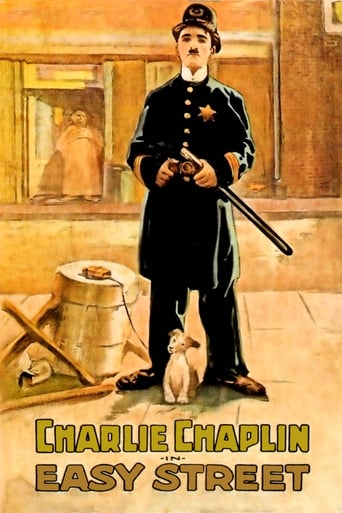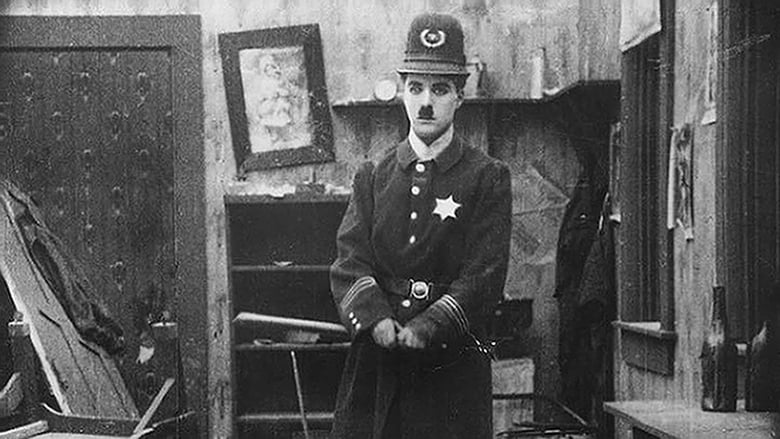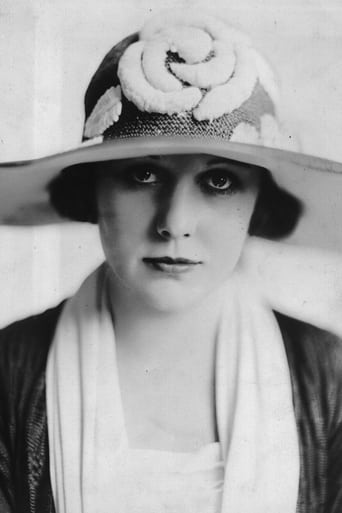

Easy Street (1917)
A derelict, huddled under the steps of a missionary church, feels enlightened by the sermon of a passionate preacher and infatuated by the beauty of the congregation's pianist, in such a way that he tries to improve his life of poverty by becoming a policeman. His first assignment will be to patrol along Easy Street, the turf of a vicious bully and his criminal gang.
Watch Trailer
Cast


Similar titles
Reviews
A story that's too fascinating to pass by...
A movie that not only functions as a solid scarefest but a razor-sharp satire.
While it is a pity that the story wasn't told with more visual finesse, this is trivial compared to our real-world problems. It takes a good movie to put that into perspective.
Great story, amazing characters, superb action, enthralling cinematography. Yes, this is something I am glad I spent money on.
EASY STREET (Mutual, 1917), Written and directed by Charlie Chaplin, stars Charlie Chaplin in another classic comedy short from his Mutual Studio 1916-17 period. A story comedy, this one contains the usual quota of slapstick, chases and assortment of characters in and around the tough district of Easy Street, with plotting that could have been lifted from a Bible story of "David and Goliath" where the meek (Chaplin) encounters with the way of the strong (Eric Campbell).Opening title card: "A new beginning." A homeless tramp (Charlie Chaplin) in the poor city district of town, sleeping by the bottom of the steps of the Hope Mission, is awaken by hymn singing parishioners. Entering the building, Charlie seats himself next to a woman and her baby. As the minister (Albert Austin) preaches his sermon, Charlie takes an interest in the young attractive organ player, Prudence (Edna Purviance), the preacher's daughter. In the meantime on Easy Street, police brave a losing battle of gang fights lead by a giant bully, Bill Basher (Eric Campbell) having the law enforcement officers carried away in a stretcher, bruised up in torn uniforms. A sign, "Policeman wanted," immediately posted outside the door attracts the attention of the passer-by Charlie. Now a new fledge police officer, Charlie's beat becomes Easy Street, which turns out not so easy when coming face to face with the meanest looking brute feared by the community, Bill Baster. Will Charlie live long enough to retire and collect his pension? Time will tell, even if it's only for twenty two minutes.EASY STREET certainly ranks one of Chaplin's finest. Though not particularly playing New York City's finest, situations depicted could very well be anywhere. A glimpse of a sign captured on screen indicates the setting to be Los Angeles, California, and not in Charlie's homeland of the dive district of London. What makes those Chaplin Mutual comedies to be his best would be his creative genius of turning a simple story and making it as funny as can be, even with serious suspenseful moments by placing hero and heroine inside a locked room with a dope fiend. Of course there's the oft-casting of Edna Purviance as Charlie's female co-star, and other staff players as Henry Bergman, Frank J. Coleman, Charlotte Mineau, John Rand and Loyal Underwood in their assigned roles. None come close to scene stealing as Eric Campbell, the bully of the district. Working under Chaplin's company for the eighth time, Campbell abandons the traditional weird beard for a dirty face, shaved head and pointy eyebrows in the matter of the devil's horns. Of the scenes depicted, the best segments are those involving Chaplin and Campbell: Campbell showing how solid his head can be as Officer Charlie hits it repeatedly with his club; a scene involving them using a street lamp; and of course, the end result not to be missed. With Campbell often labeled as "Chaplin's Goliath," for EASY STREET, he's Chaplin's Hercules, considering his super human strength and ability to break out of tight situations, including handcuffs.Aside from Charlie promoting himself from tramp to policeman, there's moments in between his official duties where he shows heart and humility towards those in need, such as a hungry woman caught stealing a loaf of bread to feed her family. For Chaplin, he doesn't do this for sentimental purposes but showing how his character can be just as human as anyone else, and still get few laughs in the process.Years before cable television broadcasts as Arts and Entertainment in the 1980s, EASY STREET had become one of many early Chaplin comedies to be shown on either public or commercial television, the latter as part of the 1960s series, "Charlie Chaplin Comedy Theater." Prints containing 1920s sounding orchestral score with singing and sound effects from 1930s reissues were most commonly shown on PBS stations prior to 1972, the same prints acquired from Blackhawk/Republic Home Video in eighties and nineties. At present, restored prints, new orchestral scoring with silent film projection speed have become available from Kino Video in both video and DVD formats , the same prints occasionally used on Turner Classic Movies (TCM premiere: December 6, 1999). Next Chaplin Mutual comedy, THE CURE (1917). (***1/2)
Charlie Chaplin as a police officer - if ever there was an inherently contradictory twist of character in cinematic history, there was one. How could Chaplin, who so frequently took a stand against the tyranny and ineffectiveness of authority figures ever cast his sweetly bumbling Tramp character in the role of one of the most present and disliked authority figures of the film's time with anything less than hilariously twisted results? It was certainly enough of a hook to guarantee promise for Easy Street, one of the many two-reeler films Chaplin created for the Mutual Film Company, but, ever the innovator, Chaplin refused to let the film coast by on its comedic concept, and instead infused enough socially conscious undertones to his film to make it a remarkably compelling and complex piece of work as well as being enormously funny. Despite the deceptively simplistic storyline, Chaplin manages to work an astonishing amount of subject matter and thematic content into a mere 22 minutes which could have been taken up by a simple serious of extended gags. While the wild fight scenes (astonishingly choreographed even by contemporary standards and alarmingly vicious for their time) and silly slapstick and sight gags suggest a typically flippant throwaway comedy (and Easy Street easily excels as such), the film lurking beneath the jovial exteriors is one of stark, devastating realism. The ironically named Easy Street proves a desolate, broken down block serving as a microcosm for the state of societal poverty, and Chaplin's depiction hardly shirks around the more unsettling elements, cheery comedy or not. From the rampant, incessant violence to the shockingly graphic depiction of drug abuse (squeezed by a more lenient age of censorship), both played mainly for laughs but with substantially dark undertones, the film paints a surprisingly despairing portrait only by its images and miraculously without ever jeopardising the comedy of the overall work. By casting his now firmly established Tramp character (here called 'A Derelict') as an unwitting policeman, Chaplin mocks authority in the spirit of his previous benefactor Mack Sennett and his infamously blundering "Keystone Cops". However, Chaplin proves more underhandedly sympathetic, suggesting the genuine plight of an organization of law enforcement so desperate that it would take the Tramp's unassuming good will and accidental good fortune to become the soul voice of reason and ultimately save the day. However, most poignantly, even when the film's primary antagonist has been defeated, the conflict is not resolved, as all of the townspeople the Tramp has saved turn on him. Despite the film's more standard sentimental ending (potentially ironically so) such dark allusions suggest that the conflict is never-ending, and brief moments of hope are only fleeting - such complexity melded into a potentially paper thin project mark Chaplin for the cinematic genius he was quickly on the way to developing into.It goes without saying that Chaplin's effortless performance as his timeless Tramp figure is easily the comedic highlight and heart of the show, capturing the audience's hearts from the first sight of him asleep huddled in a corner to every mirthful bodily twitch to wildly hilarious contortion. But Chaplin's exceptional work is not the sole performance worth noting, as his frequent co-star Edna Purviance proves as luminous and winsome as ever as a religious mission worker who captures the Tramp's heart, and character actor Eric Campbell is a truly foreboding presence despite his far over-exaggerated eyebrows as the near indestructible "bully" tearing a violent streak through the suffering town. The striking social critique lying beneath the irreverent surfaces easily make Easy Street one of Chaplin's most satisfying as well as inventively hysterical early efforts. Seldom is such humour, pathos and complexity melded so effortlessly into one concise 22 minute package, making Easy Street a perfect candidate for those looking to discover or cherish more of the timelessly endearing spirit of Chaplin.-9/10
Easy Street is the ninth film Chaplin edited, wrote, directed, and produced for the Mutual Film Corporation. Chaplin attempts to combine slapstick with social commentary in this film. For the most part, he's successful, but the film just isn't as funny as other Mutual films. Chaplin finds salvation at a religious revival and becomes a policeman. Yet he's not so coincidentally dressed as a Keystone cop, and we know we're in for some fast-paced comedy. The streets are ruled by bully Eric Campbell, who once again serves as Chaplin's foil. Edna Purviance is the religious girl Chaplin saves from a drug fiend en route to cleaning up the neighborhood. There are many moments in the film that are equally comic as well as social commentary. The lack of respect for law and order, justifying stealing from sleeping shopkeepers, and the inevitable conclusion that order and respect trumps disorder and chaos. The highlights of the film involve Chaplin's attempts to subdue Eric Campbell, first with a gas lamppost and then with an end table through an open window. The film is generally recognized as Chaplin's most well known or best from his Mutual period, but I feel that other films like The Pawnbroker and One AM are more comically inventive and funny. This was one of Chaplin's first films to utilize social commentary. **1/2 of 4 stars.
Until late in his career, Charlie Chaplin's films often displayed a real "Populist" bent--advocating, indirectly, for better treatment for the poor and basic fairness. Later in life, this was taken to be an affinity for Communism or Socialism, but at this time in history, it was strongly in sync with the American ethos. Later, after feeling disinherited from his adopted country, he showed incredibly cynicism and disgust for humanity (such as in the terribly dark MONSIEUR VERDOUX--1947).This film is probably the best example of this social conscience. Charlie becomes a policeman and is sent into the most dangerous and horrid slum to "clean up the place". Most of the film is spent trying to apprehend the chief "baddie"--a mountain of a man played by Eric Campbell. It's very funny and great entertainment to see Charlie, through wits and agility, succeed.At the end, after the town has been pacified, we see the Utopian view of society as envisioned by Chaplin. The streets are clean, people (including Campbell) are decently dressed and civilized, employment agencies and social service agencies adorn the streets and all is well. Believe it or not, this did not seem preachy or out of place, as this ideal society was well-integrated into the film and gave a sweet positive ending to the film--much better than the police just bashing the bad guys up side the head and jailing everyone. Is this realistic? Not exactly, but it sure is nice to see how he saw how life COULD be in a better world.





